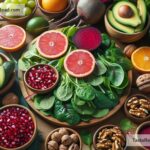Boost Your Oxygen Levels: Foods for Better Oxygen Utilization
Oxygen is life. Every breath we take fuels our body with the energy it needs to function properly. But did you know that the food you eat can impact how well your body uses this oxygen? Some foods can actually improve your body’s ability to deliver oxygen to your cells and make better use of it. Today, we’ll dive into these “oxygen-boosting” foods and how they can keep you energetic, healthy, and ready to tackle the day.
Why Is Oxygen Utilization Important?
Oxygen utilization refers to how effectively your body transports and uses oxygen. It’s especially important for athletes, busy workers, and older adults. When your body can’t use oxygen efficiently, you may feel tired, sluggish, or even short of breath. Poor oxygen utilization can lead to muscle soreness, slow recovery after exercise, and even chronic health problems. Luckily, making smart choices about your diet can help.
Certain nutrients serve as the building blocks for better oxygen delivery because they support your cardiovascular system, red blood cells, and cellular functions. Here’s a list of foods packed with these oxygen-supporting nutrients.
The Best Foods for Improving Oxygen Utilization
1. Leafy Greens
Spinach, kale, and Swiss chard are like nature’s superheroes for oxygen utilization. These greens are rich in iron, which helps to produce hemoglobin—the protein in red blood cells responsible for carrying oxygen throughout the body. Iron deficiency can lead to anemia and decreased oxygen supply, so add leafy greens to your meals for a natural boost.
Plus, leafy greens are loaded with chlorophyll. This green pigment from plants helps increase oxygen levels in the blood and detoxifies the body. Whether you toss some spinach into a smoothie or cook up a plate of kale chips, greens make for a healthy and tasty choice.
2. Citrus Fruits
Citrus fruits like oranges, lemons, and grapefruits are packed with vitamin C, which your body needs to absorb iron from food. Without enough vitamin C, even iron-rich foods can’t be fully utilized. By pairing citrus fruits with iron sources—like leafy greens or beans—you’ll maximize the oxygen-supporting power of your diet.
Vitamin C is also a known antioxidant, meaning it helps protect your blood vessels and boosts blood flow. A healthy circulatory system ensures that oxygen-rich blood is delivered efficiently to your organs and tissues. So, go ahead and start your morning with a refreshing orange!
3. Beetroot
Beetroot is one of the most powerful foods for improving oxygen utilization. Why? Because it’s loaded with nitrates—a natural compound that stimulates better blood flow. Your body converts these nitrates into nitric oxide, which opens up your blood vessels and makes it easier for oxygen to travel to your organs and muscles.
Several studies have shown that drinking beet juice before exercising improves endurance and performance. If you’re not a fan of the taste, you can grate fresh beetroot into salads or blend it into smoothies for a nutritious boost.
4. Fatty Fish
Salmon, mackerel, and tuna are rich in omega-3 fatty acids, which support heart health and reduce inflammation. Why is this important for oxygen utilization? A healthy heart pumps oxygen-rich blood more efficiently. Omega-3s also improve your body’s ability to absorb oxygen during exercise and physical activity.
If fish isn’t your thing, you can opt for plant-based sources of omega-3s like flaxseeds, chia seeds, and walnuts. Adding these to your meals will still provide great benefits.
5. Berries
Strawberries, blueberries, and raspberries pack an antioxidant punch. These tiny fruits fight oxidative stress in your body, which can otherwise hinder oxygen delivery to cells. They also improve circulation, helping ensure your muscles receive the oxygen they need during exercise.
Berries are versatile and can be enjoyed on their own, added to yogurt, or blended into smoothies. Make a habit of eating these colorful fruits to keep your oxygen levels high.
6. Whole Grains
Whole grains like brown rice, oats, and quinoa are excellent sources of magnesium. This mineral plays a key role in relaxing your blood vessels and improving oxygen delivery. Whole grains also provide energy-boosting carbohydrates, which your body needs to burn oxygen efficiently.
Next time you’re building a meal, swap white rice or bread for whole-grain alternatives. Your body will thank you!
Lifestyle Tips to Support Oxygen Utilization
While eating the right foods is important, overall lifestyle changes can make a big difference, too. Here are some tips:
- Stay Active: Regular cardiovascular exercises, like jogging or cycling, keep your heart pumping and your oxygen system efficient.
- Stay Hydrated: Drinking enough water helps blood circulation and allows your cells to make better use of oxygen.
- Avoid Processed Foods: High-sugar, high-salt foods can harm your circulatory system, slowing down oxygen flow.
Final Thoughts
Your diet plays a big role in how your body uses oxygen. Foods rich in iron, antioxidants, nitrates, and healthy fats can improve blood flow, boost hemoglobin production, and support your overall wellness. From leafy greens to fatty fish, each of these food choices contributes to better oxygen utilization—and ultimately, better energy and vitality.
The next time you plan your meals, think of ways to incorporate these foods into your diet. Whether it’s a spinach salad, a glass of beet juice, or some grilled salmon, these simple changes can go a long way in helping your body perform at its best. Oxygen may be invisible, but its impact is powerful—and the right foods can help you harness its full potential!


